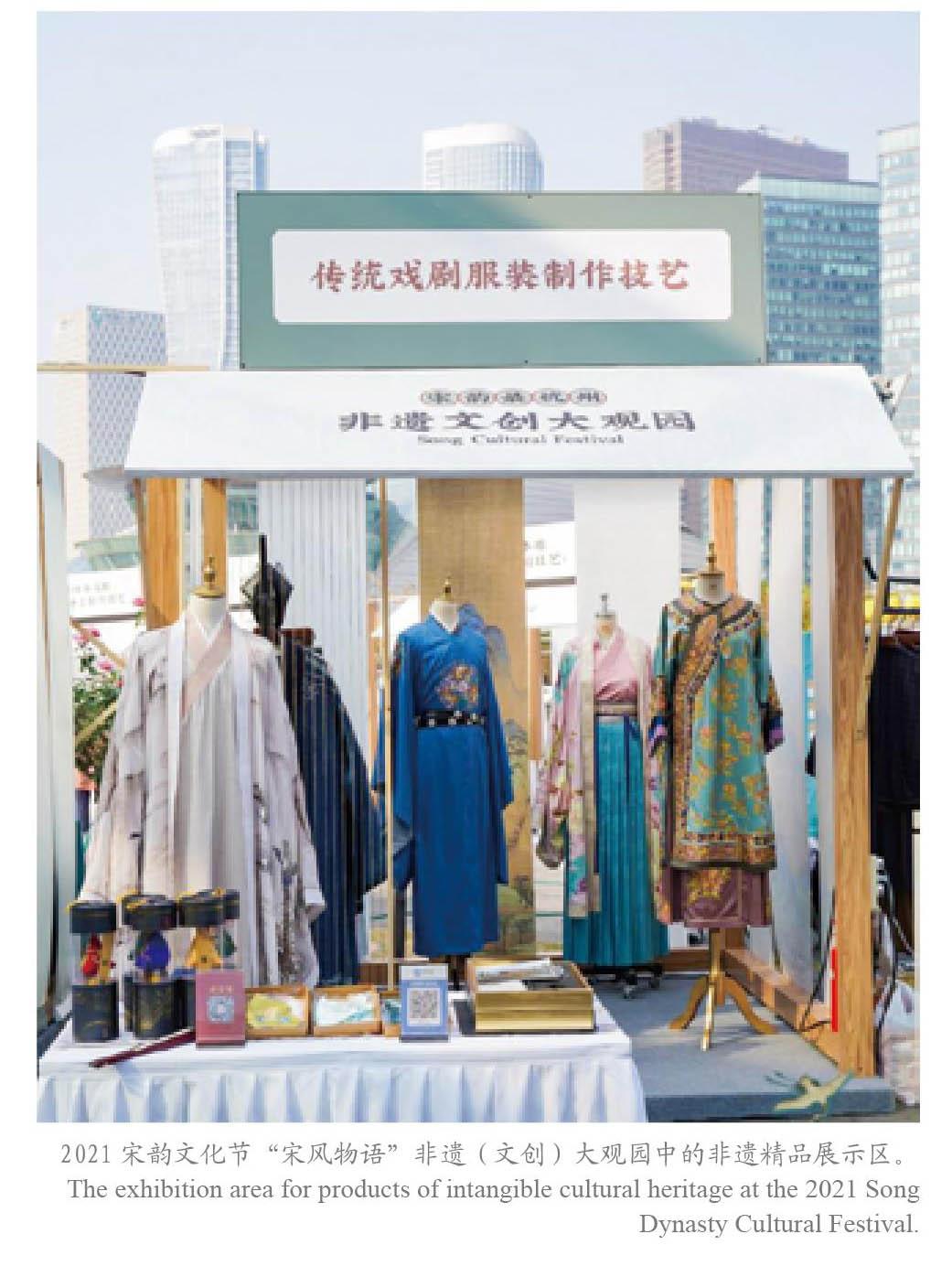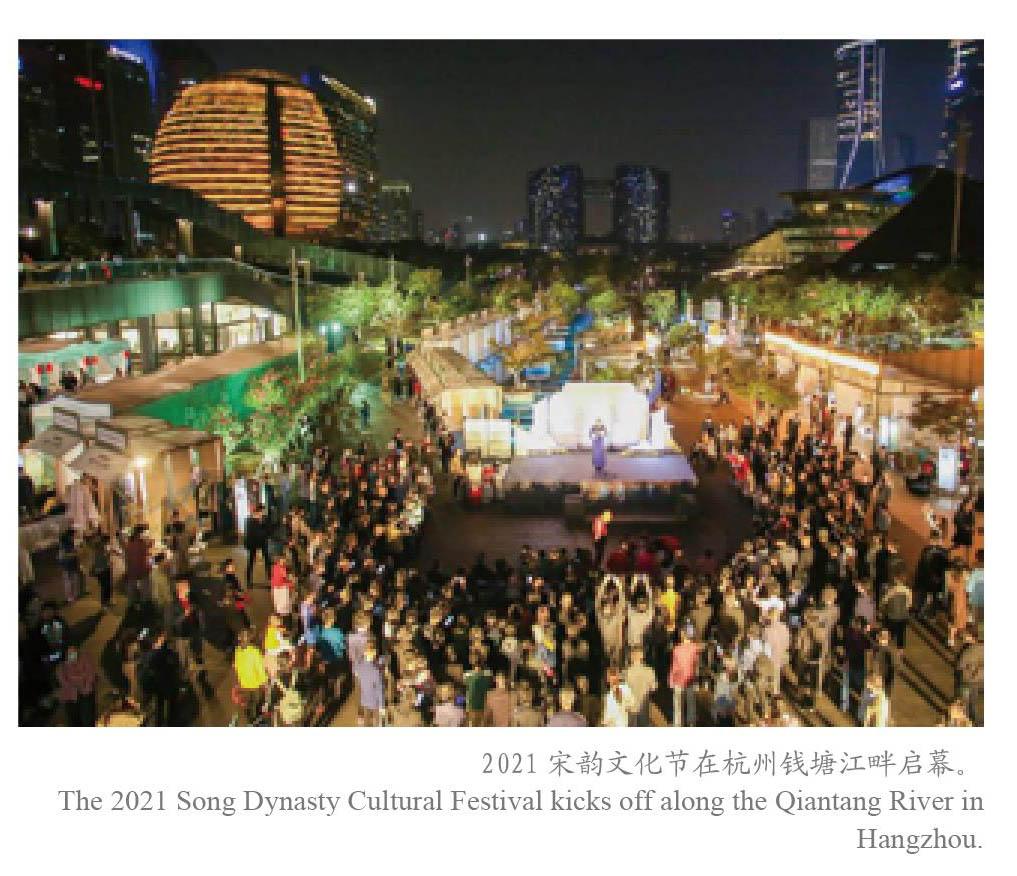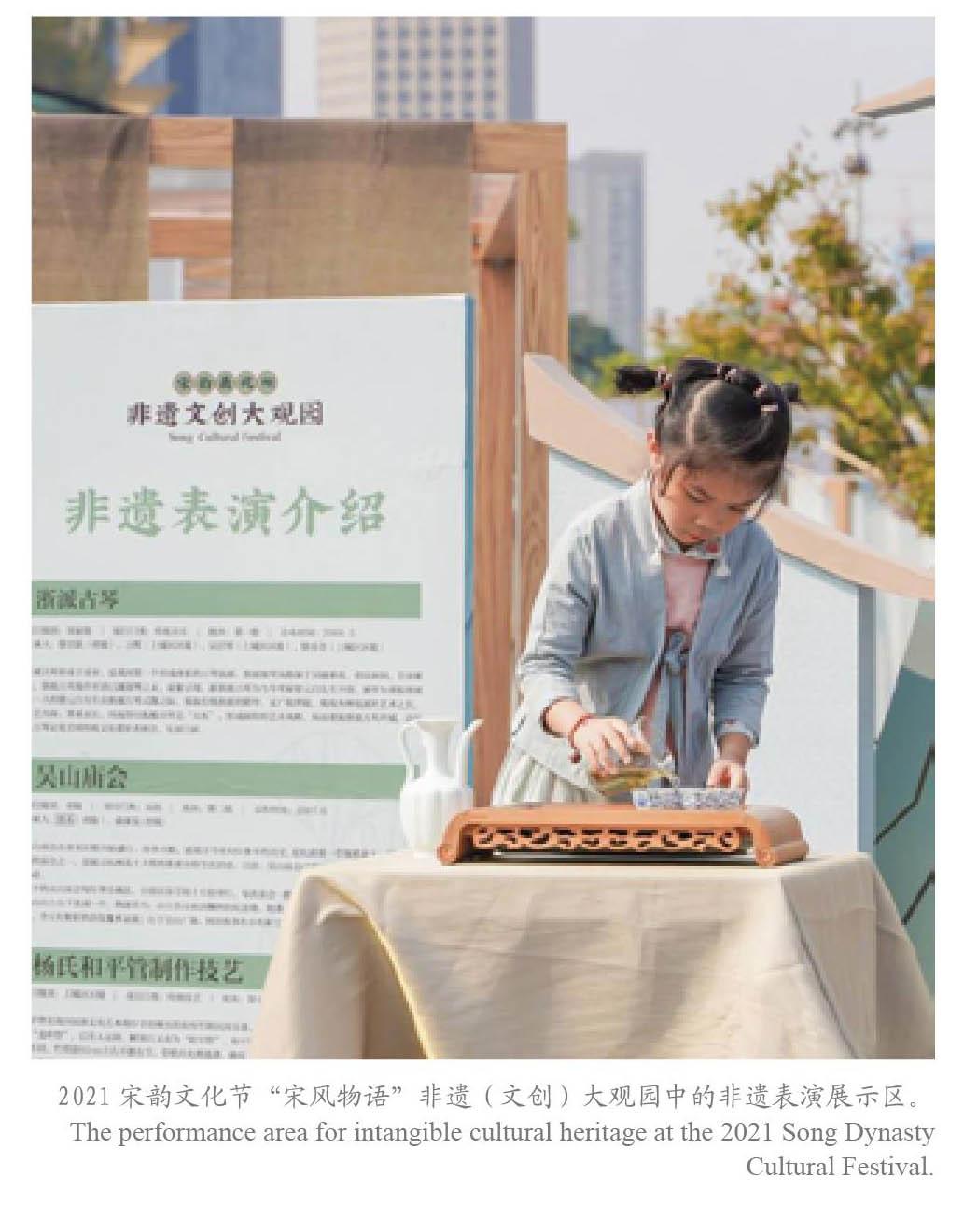杭州的“上乘”宋韵
鲍亚飞








编者按:韵者,美之极。宋韵,两宋文化的精華所在,代表了当时物质文明和精神文明的高峰。杭州市上城区,作为南宋皇城遗址所在地、南宋文化发祥地、宋韵文化传承展示中心,是全国宋韵文化积淀最为深厚、保留最为完整的地区。以文化的力量,展现这块南宋根脉所系的核心区域;以文化的自信,追摹那个流淌千年、传承至今的“上乘”宋韵。
从900年前的河南开封到立朝152年的南宋临安,中间隔着将近1000公里。
相较于开封“一城宋韵半城水”的平面印象,杭州的宋韵更加立体一些——无论是看得到的精致,还是感知得到的精神——比如街衢、运河、建筑、官衙,比如技艺、审美和生活。让人惊喜的是,这些成果还比较完整地传承到了今天。
从九里皇城到南吴山北武林13座城门,钱塘清波里住着120万人口。
赵构到杭州后,选凤凰山麓临安府治为基营建大内:不合规制的“坐南朝北”、太庙和社稷方位。但这并不妨碍它成为“宏伟瑰丽、工力精致、金碧流丹、华灿照映,望之若天宫化成”的阆苑仙宫。据已经发现的宫城北城垣和东城垣推测,宫城的位置在杭州城南的凤凰山之东——偌大一座宫城,金砖踏地,竟然都在上城之中。
这13座城门和152年的“上乘”宫城最终铸就了文明的高峰——“中国历史上的第二次百家争鸣”,缔造了“第一次的东方文艺复兴”和“世界伟大海洋贸易史上的第一个时期”。那个文明而富庶的朝代缓缓走来的时候,给我们也给世界打开了神奇大门:其“百花齐放”的文化、“市坊合一”的商业、“百工竞巧”的技艺,综合而成一个“诗情画意”的东方。
如果可以穿越,我会去宋朝,去认识四分之三的古代发明,去领略吴山天风的空灵奇绝,去感受“宝马雕车香满路”的一世繁华,去体验“点茶、焚香、插花、挂画”的雅致生活……
小可精致入文 大可进取卫国
进士辛赞的命运确实有些不济。
38岁的年纪正是要在仕途上大展宏图的时候,“靖康之变”发生,北宋亡了。
身边的友人早前就已急急忙忙跟着高宗南渡,他却没有。一是因为他的族人太多——“以族众,拙于脱身”;二是因为他心里有一个更大的计划:隐忍滞北以保实力,待王师北伐,持械与金决。之后的很多年里,他接受金国的拉拢,违心地到朝廷做官,几经升迁后竟然做到了正三品的开封知府……但他终于没有做回自己心心念念的宋人。
为求“宋人”身份而孜孜的辛赞并不为人熟知,但由他带大的孙子,你必然是清楚的。
《射雕英雄传》第八回里,黄蓉恢复女儿装扮后去见郭靖,并在舟上唱了一首曲儿,说:“这是辛大人所作的‘瑞鹤仙’,是形容雪后梅花的,你说做得好吗?”郭靖是北方人,向来生活在大漠深处,没有听过这首曲儿,更不知道词的含义,甚至发问“辛大人是谁”。
这“辛大人”就是辛赞之孙辛弃疾,他曾5次到杭州、7次被弹劾,一生都在力图收复失地,一个和李清照同高的“济南二安”、到死都在念叨南宋杭州的人。
辛弃疾是名人之后,书香世家,随便一首他的词都够你我写一辈子:《西江月 · 夜行黄沙道中》《清平乐·村居》《永遇乐·京口北固亭怀古》,当然还有《念奴娇 · 西湖和人韵》《好事近·西湖》《满江红·题冷泉亭》。
一个人一辈子能把文章做好就已非常圆满。但他不,非要在沙场上也做出个独一无二来。
绍兴三十二年(1162年),23岁的辛弃疾仅带五十名义兵就敢冲进五万人的金军,他还能捕获叛逃头目张安国,甚至还顺带策反了近万人马,一路无事南归杭州,于是南宋朝野轰动。这是怎样的一种勇气和智慧?宋高宗“壮声英概,懦士为之兴起”,一见三叹。
辛弃疾第二次到杭州时,受宋孝宗延和殿召见,被任司农寺主簿——管着农业的7年时间里,辛弃疾满脑子想的却都是恢复中原之事,写出著名的《九议》。
继淳熙元年(1174年)春、绍熙三年(1192年)秋两次留杭之后的1204年春,辛弃疾第五次到杭州,出任抗金前线——镇江的知府。距第一次来杭已经40年,过往如弹指之间,他思绪万千,或有意气,或因遗憾,写下“千古兴亡多少事,悠悠,不尽长江滚滚流……”
但,这是他最后一次。
到开禧三年朝廷令他“速赴临安”任枢密都承旨时,辛弃疾已病重卧床不起。同年10月3日,他喊着“杀贼!杀贼!”而逝,年六十八岁。
年少不懂辛弃疾,读懂已不再少年。
很多人不太喜欢辛弃疾,觉得他的词重于征战和杀伐,他的为人又过于偏执和不知变通。我却不觉得。相反,对于杭州,我认为辛弃疾是唯一的存在——既写下了文人的刚毅,又战出了将军的温情。
可能说得有些远了,今天要写的是“宋韵”;当然,也可能没有太远——辛弃疾这样一个“小可精致入文,大可进取卫国”的人,这种品性可以理解为一个更高层面的宋韵。
宋韵到底是什么呢?是斑驳的老城墙、鼓楼回荡的钟声,还是薄暮晚烟在山水画里弥散开来的雅致?是两宋文化具化在物质和非物质文化遗产中的进步思想、高尚情操和美学观念,还是整体浸润在宋式生活里的文人风骨、艺术修养与包容气质?
“风雅处处是平常。”我不太敢下定义,只能说,宋韵是一种符号,一种全面延续至今并照向未来的态度符号,包括上面那些,又不限于那些。
上城,承托所有的南宋繁华
从来没有一个王朝,如南宋一般,宛若蝶变,在挣扎中绽放绚烂,从一开始就将精致交融在夷族的铁蹄之边。一面你为它的半壁残垣惆怅哀叹,另一面却更臣服于它臻于极致的妩媚与嫣然。
我再说得直白一点:在时刻提防踞江而视的金军面前,南宋朝廷竟然用一半的国土创造出了从未有过的繁盛,让封建王朝只有在这个时候才真正到达巅峰。
巅峰,首当其冲的指标是人口。人头密疏就像今天人们的存款多寡。为了探寻这一点,我特地去查过《宋史》:徽宗崇宁年间,杭州有户20余万,人口近30万——当时,即使是伦敦、巴黎、威尼斯等城市的居民数量也不过十万——杭州地区(算上钱塘、仁和、临安等九县)人口约100万。到了南宋咸淳年间(1265—1274年),杭州地区的人口达到了约124万。
甚至,这个数字还有漏隐。因为元初曾對“杭州路”人口进行过复核,发现人口总数约为183万,光杭州城区的人口就达到了50万左右。这实在让人惊讶。
一个朝代的繁华体现在城市人口,而人口的聚集则是因为生活的平和。
顺着我的思路往下读,你会更惊讶——早在800多年前,南宋杭州就已“无有宵禁”——有早市夜市,经商自由,又因交通便利,城里城外商铺繁多。《梦粱录》云:“杭城大街,买卖昼夜不绝,夜交三四鼓,游人始稀;五鼓钟鸣,卖早市者又开店矣。”从这个角度来说,那个时候的杭州就已经是一座不夜之城。这在封建体制“束民乃安”的普遍认识下,南宋就是一个仙境的存在,难怪一时间“八荒争凑,万国咸通”。
一不小心,杭州就成为了当时南宋的第一大都市,并且还是当时世界上最繁华的大都市之一。
如果你觉得这还不足以说明南宋的高峰,那么还可以再看一看文和学。
这里也有一组数字:南宋书院总数为442所。唐、五代、北宋共500余年间所有书院的总和(143所),也只有其总数的三分之一——你能想象吗?一个封建王朝是以一种什么样的决心在心向院学?
有一个声音躲在角落说:“别忘了,南宋是个偏安一隅的南宋。” 另一个声音又响起来:“从来不否认南宋的偏安,但千万别只看到它的偏安。”
对南宋的“偏安”我一直是有些忐忑的,好在我非常倾慕的陈寅恪先生给我解了围。他认为:“华夏民族之文化,历数千年之演变,造极于赵宋之世。”这个“赵宋”当然包括南宋,我觉得老先生是给我们定了个调。
这个“调”其实又和赵构选择杭州有关。
不可避免,我们要回忆那段赵构最不愿提及的过往——因为只有他更清楚个中滋味,所以无论多少人劝,他为什么还是选择杭州。
1127年,赵构在商丘建南宋,但金军侵来,无人可挡,他只得去往江南,带着妻儿、随着军士。金军一路追了700公里仍不松劲,直直地又把赵构逼出杭州、迁向宁波。“宁波也不能待了,他们又来了。”赵构乘船退至海上,后又因金军搜山检海,赵构只得转走温州……
这一次,赵构可能有了两个心思:第一是好险;第二是海路才是退路。
赵构的一切都只有一个目标:“安定”。建炎三年(1129年),在当时那种敌嚣我消的氛围里,赵构把杭州知府衙门升为行宫、升为临安府。一直到金兵北撤的绍兴元年(1131年)十一月,他才派人开建宫殿,仅仅几个月后就携百官在杭州办公。有人力谏定都金陵,但赵构想金陵并不安全:金军并非没有打过。他是怕了,万一金兵再过长江,从杭州出海避难更便捷,这至少还能保住一个南宋核心。
也正是这个选择,杭州变为唯一的答案。于是,设官衙、办太学、课农桑、布市井——《淳祐临安志》载,临安城内共有坊巷八十九条,原本应该限制的大街和坊巷纵横交叉之处却商店林立,御街两侧更是如此。“珠玉珍异及花果时新海鲜野味奇器,天下所无者,悉集于此。”仅7年后的绍兴八年(1138年),杭州城垣已分内城、外城:内城,即皇城,方圆九里,环绕着凤凰山,北起凤山门,南达江干,西至万松岭,东抵候潮门,在皇城之内,兴建殿、堂、楼、阁,还有多处行宫及御花园。外城设城门13座,南跨吴山,北截武林门,右连西湖,左靠钱塘江。
皇城是皇脉核心,这核心全在上城区域里——所有的包括建筑、技艺、市井等都是由这个根本蔓散开枝而去,失去了这个根,其他的都是不着实地之毛。用今天的无人机飞上去看,南宋皇城遗址所在地,北起西湖大道,南至宋城路,西接南山路,东抵建国南路。核心区规划面积1.2平方公里,包含宫城内——皇宫遗址、三省六部、太庙、二十三坊、鼓楼等区块;宫城外——清河坊、御街、五柳巷皇家园林、劳动路国学文化长廊等。
一个上城区就这样几乎承托了所有的南宋繁华。
这些“根”都集中在这一处,于是今天来写宋韵——无论是宋韵最“上乘”,还是宋韵最“上城”,都无可置否。
宋韵归集地 何以是此处
一边是隔江对峙的重压,另一边是绚烂瑰丽的进步,宋韵品咂多味。
中国人重“根”,只有根才是本,其他的都是蔓散和开枝。现在可以抛开一切纠结,专心地谈一谈上城之于杭州宋韵了。
上城,是杭州的一个区,和杭州古都一样的年纪,是宋韵的归集地——前面说了,南宋皇宫就在这里。
皇宫?是的,俗人心里想象的角徵绕、珍馐盛,而且藏无数宝贝的皇宫。
2004年7月,已经投资了3000多万元的万松岭隧道建设确定“让路”,原因是杭州市文物考古所在2003年12月开始的抢救性考古发掘中发现:在1200余平方米的地方,有南宋时期的道路、殿址、围墙、河道、石砌水闸设施等——这就是“南宋御街”。真的会为几块破砖烂瓦而停工!这一点上我不得不佩服杭州主政者的睿智:既保证了当下的交通,又护住了一个千年的皇宫。
同时被发现的还有500多片瓷片,光是它们就足以让人咋舌。南宋迁杭后,第一时间就选址建造了修内司官窑(后有郊坛下官窑),烧制专供宫廷使用的青瓷。这就是鼎鼎大名的“南宋官窑”:以“紫口铁足”“粉青釉色”“冰裂纹片”“薄胎厚釉”四大特征著称于世。南宋官窑是个什么级别?如果哪个博物馆一件没有,问起来就会脸红,不敢应声!
当然还有更早之前发现的太庙、孔庙和八卦田。
上城,只有这些?不,不止——
还有素有“杭州建筑历史博物馆”之称的清河坊——以御街为脊骨,鱼骨状联系各坊巷的格局,奠定了杭州历史城区的基本空间结构。在中山路一带,这些坊巷至今仍有大量遗存,其中保存较完整的历史风貌和空间格局的街巷有近20段。史学家、考古学家又集齐研讨——老底子这么多且厚,全部保护?大家于是在上城区画了一个圈,这个圈的范围达3公顷……
杭州上城的风物、戏曲、风俗于是都融浸在了这个圈里,都有特殊的自我标签,美之若荷、精之如簧——我看到的是,拥有440行商贸的南宋人硬是把负重的生活过成了一种极致的向往。
唐人一个简单的“品茗”,到这时已被演化出斗茶、分茶、点茶等“茶百戏”;唐人行酒令,到这时已演变成小词、散曲;唐人的拉面,在这时也演化出了擀、削、拨、抿、擦、压、搓、漏、拉等十余种制法,丝鸡面、三鲜面、鱼桐皮面、盐煎面、笋泼肉面、炒鸡面、大熬面、子料浇虾面、银丝冷淘等琳琅品种。这个阶段的人在吃喝以及餐具方面的要求非常高,精细贵重,甚至首创了分食制。
保护和传承 韵之绵长
和以往任何王朝不一样,152年所蕴含的宋韵内里完整地留给了现在。比如上面提到的风物、戏曲、风俗;比如艺术、技术和建筑;比如当时的南宋留给世界的影响——浙江的海,依然是世界海上贸易的重要关口;上城的山,依然奠定着中国园林叠山审美的范式。
我知道这些——宋人的生活方式和隽永深沉的生活美学,对后世产生了深远的影响;宋代的文化基因藏在杭州这座城市里,藏在上城的脉络里,世世代代的杭州人以自己的方式演绎出别样精彩的韵律。
我也知道这些——从宋代的西湖到如今和谐共享的世界文化遗产;从崇文向学的浓厚氛围到当代书香浸润的阅读型杭州;从“晴窗细乳戏分茶”的惬意情趣到以茶会友的国际盛会;从繁华喧嚣的瓦舍勾栏到数智城市的宜游宜居。
但,好像还不够。传,是一种历史对当下的馈赠;承,是一种当下对过往的责任。独一无二的南宋留给我们千年难见的宋韵,我们还能做点什么?
在白苏二公帮我们尽心“国内推广”,马可·波罗也早把这个城市带向了世界的“Heaven City”的当下,两个问题现在可能还需要思考:
第一个是宋韵给上城带来了什么,给杭州带来了什么?我们又应当如何把宋韵带去给世界?
第二个是如何实现传统文化的现代表达,厚重文化的时尚表达?“处处宋韵”的另一个面是文化遗存的空间分散,那么我们又该如何聚沙成塔形成合力?这种合力又该如何转变为市场内涵,并真正切入到一种主动的文化传承?
当然,这些发问不是为了改变宋韵在我心里的敬仰和崇拜,相反是为了让从皇城到新城的转变中,新上城所呈现的宋韵文化、钱塘江文化更加繁荣。
宋韵的保护和传承,上城一直在做。首先是研究,通过文化基因解碼,从七百余个基本文化元素中提炼出“德寿宫遗址”“南宋官窑”“八卦田遗址”等宋韵文化元素。再是传播和转化,通过举办文化活动、开发宋韵IP文创衍生品、深化文旅融合等方式,让宋韵文化散发新的活力和光彩。不久的将来,德寿宫遗址保护展示工程、南宋皇城大遗址保护工程、南宋博物院筹建项目,龙居寺、海潮寺、五柳巷、草桥亭、皋亭山,还有许多个散布于上城的宋韵珠玉,都将向我们奔赴而来。
宋韵从千年前向我们走来,可观,可感,可传承,可亲近。宋韵的平民化让我们感动,几乎和今天我们的生活一样。北魏敦煌壁画的飞天,很美;唐代侍女的服饰,很美。但只有宋韵之美,才能真正被我们的价值观在灵魂和世俗中接受——毕竟,我们早就对这种与生俱来的“上乘”味道萌发了天生的亲切感。
(杭州市上城区委宣传部为本栏目提供支持)
In Search of the Essence of the Song Culture
By Bao Yafei
Editor’s note: It is the place where the Imperial City of the Southern Song dynasty once sat, the Southern Song dynasty culture was born, the Song dynasty culture and heritage are showcased, and where the Song dynasty culture has been kept most intact in China. The Shangcheng district in Hangzhou is a mirror of all the prosperity the Southern Song dynasty once enjoyed. It is where Song Yun, or the essence of the Song culture, lies.
Nearly 1,000 kilometers separates the city of Kaifeng in Henan province from the city of Hangzhou in Zhejiang province.
Compared with Kaifeng, which was once the capital city of the Northern Song (960-1127), the manifestations of the Song culture are more three-dimensional in Hangzhou, erstwhile capital city of the Southern Song (1127-1290). In Kaifeng, it is said that “half of the Song culture is in water”, referring to its many lakes and the water system established during the Northern Song. Whereas in Hangzhou, streets, canals, architecture and government buildings, craftsmanship, even aesthetics and lifestyles dating back to the Southern Song still remain intact today or have been passed down throughout the generations.
When Zhao Gou, Emperor Gaozong of Song, arrived in Hangzhou, he chose the government seat at the foot of the Phoenix Mountain as the place to build the Imperial City. Despite “sitting in the south facing north”, instead of the traditional “sitting in the north facing south”, the Imperial City was still as “magnificent, exquisite, resplendent, shining as if the heavenly palace has descended on the earth”. Judged from remains of the north and east walls of the palace, the whole palace was inside Shangcheng district. Indeed, it was within the Imperial City that “the second Hundred Schools of Thought in Chinese history” took place, “the renaissance in the orient” was born, and “the first stage of global maritime trade” emerged.
To 38-year-old Xin Zan, it was probably the worst of times. Just as he was about to fulfill his aspirations, he suffered a crushing blow: the two emperors of the Northern Song were taken prisoner by the invading Jin (1115-1234) troops and the dynasty quickly fell. Because of his large family and, more importantly, because of his secret plan to fight the Jin forces once the Song dynasty recovered, Xin decided to stay put, rather than fleeing to the south. In the following years, he even pretended to serve under the Jin rule. Unfortunately, his dream to become a Song people once again never materialized.
Some of the readers may not be familiar with Xin Zan’s story, but they must have heard of his grandson, Xin Qiji (1140-1207), who was raised by Xin Zan as his father died early. In Xin’s childhood, his grandfather often told him about the time when the Song governed the north, asking him to be an honorable man and seek revenge.
Xin had been to Hangzhou five times throughout his life, which had been devoted to the recovery of Song’s lost territories. In 1162, a 23-year-old Xin Qiji, together with some 50 brave warriors, raided a 50,000-strong Jin military camp. Not only did he capture a traitor general, but he successfully persuaded about 10,000 former Song troops to come back with him all the way to Hangzhou, causing quite a sensation in the Southern Song. The second time when Xin was in Hangzhou, he was appointed to oversee agricultural matters. But in the next seven years, what occupied Xin’s mind was still taking back the north and he wrote the famous Jiu Yi (or Nine Theses), spelling out the strategies for Southern Song’s defense and offense against the enemy.
After two stints in Hangzhou in 1174 and 1192, Xin arrived in Hangzhou in 1204. This time, he was asked to be the prefectural magistrate of Zhenjiang, the frontline against the Jin invaders. Over 40 years had passed since his heroics, and Xin uttered one of the most memorable lines in poetry, “Dynasties rise and fall, as time goes by, only the flowing Yangtze River passes before my eyes“. Three years later, when the imperial court ordered him to report to the emperor immediately, Xin was too sick to travel. On October 3, moments before he died, Xin was still shouting “Kill the enemy! Kill the enemy!”
Some might argue that Xin’s poetry focused too much on war and he was too stubborn a person. On the contrary, Xin’s poetry, and his identity as both a poet and a soldier, is an ideal embodiment of the essence of the Song culture, combining steeliness (as a poet) with tenderness (as a soldier).
Of all the Chinese dynasties, the Southern Song dynasty is the most unique in the way it achieved its success: despite losing half of its territory, despite facing a strong enemy at its border, ready to attack at any time, the Southern Song dynasty created unprecedented prosperity. Between 1102 and 1104, Hangzhou boasted a population of 300,000, compared to no more than 100,000 in London and Paris. The “greater” Hangzhou area, which included the nine surrounding counties, had a population of about one million, which grew to 1.24 million between 1265 and 1274. In fact, the figure was a gross underestimate as a census by the Yuan dynasty (1206-1368) later found the figure stood at 1.83 million, with Hangzhou’s population reaching half a million.
It was also during the Southern Song that “curfew” was lifted, business spirit greatly liberated and transportation significantly improved. According to Mengliang Lu, or Dreaming Over a Bowl of Millet, a classic record on Hangzhou at the time, “Businesses along Hangzhou’s streets run day and night: people only begin to disperse deep into the night; but at daybreak, the morning market starts to bustle again.” Its booming commerce attracted “countries from all around the world”. On top of economic and social development, a total of 442 Shuyuan, or Academies of Classic Learning, were established during the Southern Song; the combined number of Shuyuan established in the past five centuries, i.e. from the Tang dynasty (618-907) to the Northern Song dynasty? 143.
For some, these accomplishments are still “tainted”, as the Southern Song decided to settle in a “corner”. However, it was a choice as much forced by circumstances as from serious strategic consideration, which, it was argued, was that at least the core, or the roots of the Southern Song could be preserved.
That core, it so happened, was concentrated in one single place, the Imperial City, the entirety of which is located in today’s Shangcheng district, extending to the West Lake Avenue to the north, the Songcheng Road to the south, the Nanshan Road to the west and the Jianguo South Road to the east. When the remains of the Imperial City were first discovered in mid-2004, a tunneling project under the Wansong Hill, which had already cost over 30 million yuan, was temporarily halted to make way for its excavation and conservation. Eventually, with a new design, the project was successfully completed while at the same time all the archeological work went on smoothly. But it shows how the Chinese people care about their heritage.
Over the past two decades, the Shangcheng district government has spared no effort in protecting the Song dynasty heritage, which includes not only architecture and relics, but also social customs, arts and craftsmanship, through research, through integrating them into tourism and, more significantly, through making them part and parcel of ordinary people’s life. That, perhaps, is where the real beauty of the Song dynasty culture resides.

